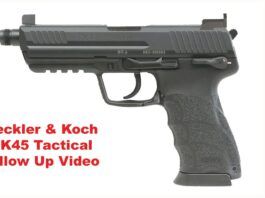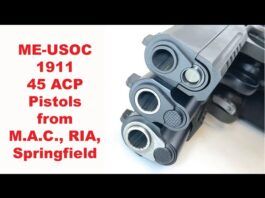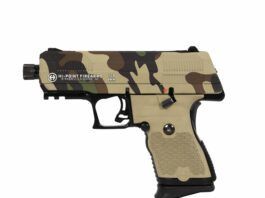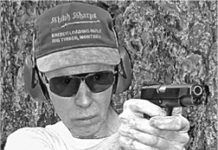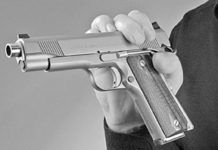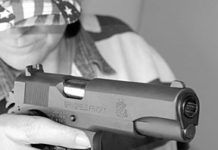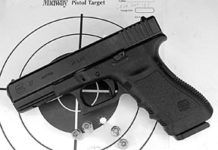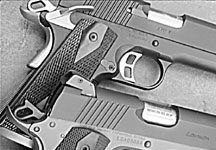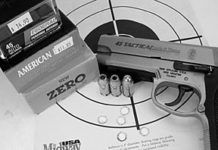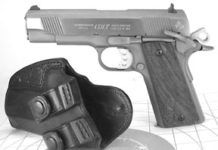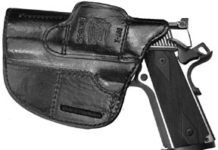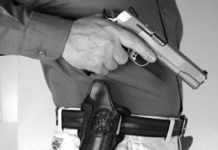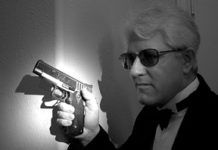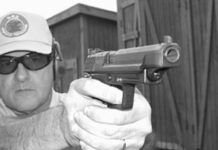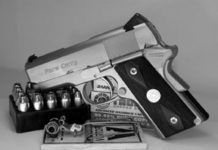A Pair of High-Dollar 1911s: Nowlin Versus Rock River Arms
High-grade 1911s can do a multitude of tasks for their owners. The jobs can include NRA target shooting, various action-oriented competitions, hunting, and of course self-defense. In this report we look at two relatively high-dollar 1911s to see how well they might work for any task to which a good .45 might be put. The companies who made the guns suggested these are target-grade or match-specific weapons. Yet each came with very similar and rather special modifications that told us the story only began with accurate target busting.
Serious Shooting .45s: Springfield Armory Edges out Gunsites Colt
The $1,560 Springfield Armory TRP and the $1,495 Colt Gunsite 1911 45s prove to be "pro tools" worth the extra investment.
Parkerized Mil-Spec 1911 .45s: Springfield Beats Auto Ordnance
Playing G.I. with the Springfield Parkerized Mil-Spec, $559, was more fun than with the Auto Ordnance 1911, $515.
Lightweight Carry Options: A 9mm, a .40 S&W, and a .45 GAP
Glock's new $640 Model 37 excels with a brand-new round. Smith & Wesson's titanium $812 4040PD opens new doors, but the $550 FN P9 comes up short.
Expensive 1911s: Kimber, Lone Star, and Wilson Shoot It Out
We pit a trio of custom production guns and learn a lot about what makes a topnotch .45 ACP. But did we like Kimber's LTP II, the Lone Star Lawman Match, or Wilson's CQB best?
Non-1911 .45 ACP Single-Stack Pistols: Sigarms Versus S&W
In the fall of 2003, Earnest Langdon captured the Custom Defensive Pistol Division (CDP) at the annual International Defensive Pistol Association (IDPA) championship match held in Little Rock, Arkansas. That Langdon, a top competitor in the Practical Shooting ranks, was victorious is not news. What was news is that he did it competing with a traditional double action Sigarms P220ST pistol rather than a custom 1911, the type of pistol for which the CDP division was founded upon. Naturally, we wanted to know what was so special about this gun. Taking a quick look at it, we immediately recognized that another pistol, the Smith & Wesson 4566TSW, was similar.
We couldn't wait to strip these guns down and see if they differed radically on the inside, and then take them to the range. Keeping in mind that an IDPA Custom Defensive Pistol was allowed plenty of leeway in terms of modification we also wanted to find out if these pistols could be "hot-rodded" with aftermarket parts. What we found impressed us.
Lightweight .45 ACP Commander Pistols: Colts Sets the Pace
To produce a sidearm that is portable, the key is to reduce weight and size. Before the advent of durable plastics such as polymer, the only alternative was to fashion the frame from a metal alloy. Minimizing the weight of the barrel and slide is generally limited to making it shorter, which also makes the gun more concealable and easier to draw. A number of manufacturers have expanded their product lineup by adding smaller and smaller versions of full-sized models while leaving the basic design intact. One of the first variations in size that stayed true to the original design was the Colt 1911 Commander. This pistol first became available shortly after World War II. The primary variation from the Government model was a reduction in barrel length from 5 inches to 4.25 inches. This made the Commander more portable and easier to handle without reducing magazine capacity.
The subjects of this test not only have shorter barrels but also employ alloy frames further reducing their weights. Our three test guns were chosen because they represent different ways of getting the job done. Of the three pistols in this test the lightweight Colt model was the most direct descendent of the original Commander. Kimber's Tactical Pro II was a radical variation with a shorter barrel set atop a full size 1911 frame. Our third test gun was the High Standard Crusader Combat Lightweight. This 1911 sells for much less than either the Colt or the Kimber, so we were hoping we had found an inexpensive downsized 1911. Here's what we learned.
Specialty .45s: Great Shooting, or Signature Editions to Lock Away?
It is not unusual to open the pages of a gun magazine and find advertisements for guns adorned with a celebrated name or a limited-run designation—some might call them "signature" or "specialty" guns because of their unique production status. We recently tested three such pistols from two makers, Springfield Armory and Kimber. Our Springfield products were the $925 Black Stainless model and the $1,900 Rob Leatham TGO II. From Kimber, we evaluated a $1,300 Team Match II, all in all a pricey trio of .45 ACPs.
When we received our Rob Leatham TGO II signature model from Springfield Armory, we wanted to know if this was a match-ready custom pistol or a collectible. The same goes for Springfield's Black Stainless model, which was absolutely striking. It featured a combination of brushed stainless steel surfaces contrasted with an artfully applied flat-black finish. We couldn't help but wonder if this pistol was meant for "serious" work. Another 1911 .45 single stack that captured our imagination was Kimber's USA Shooting Team Match II. In terms of serious 1911 features, it seemed to have all the right stuff plus red, white, and blue checkered grips. But it takes more than fancy grips to produce excellence. We wanted to know if these pistols were shooters or showpieces. Certainly, these guns will maintain or even gain value simply by putting them in a glass case, but Gun Tests is not about the Blue Book. We are about the banging and the clanging, hitting the center of the target fast and true. In a time when custom variations of the .45 ACP 1911 abound, we wanted to find out if these guns were truly special. Was the Kimber worthy of an Olympic shooting team endorsement? Would Rob Leatham, arguably the greatest practical pistolero of all time lend his name to anything less than a stellar 1911 .45? Was the beauty of the Springfield Black Stainless only skin deep? We shot them to found out:
Philippine 1911s: Do Foreign .45s Compare To A Big-Name Pistol?
Today, the consumer has more sidearms to choose from than ever before. Manufacturers have greater technical, metallurgical, and mechanical capabilities than ever before. A wider variety of effective firing systems have been developed over the last half century alone than perhaps in all the years prior. (Not to mention alternative materials such as polymer and titanium.) But which firearm do the majority of competitors prefer, and which system is making a comeback in the elite forces of the military? The Browning-based 1911 pistol. Perhaps this is why Smith & Wesson has decided to enter the 1911 sweepstakes with a just-introduced gun, the SW1911 No. 108282, a 5-inch 8+1 stainless single action that lists for $895.
Another reason must be the desire to recapture markets that S&W previously dominated with wheelguns, such as law enforcement. When the world of blue went to the semi-automatic pistol, the company's pistols were competitive, but they've recently disappeared from the holsters of many departments. The SW1911 will obviously seek to reverse that trend.
But there are plenty of other 1911 makers looking for a spot in the market. For example, we've been charting the progress of various firearms from Philippines-based Armscor. Though we have recommended some Armscor products, such as some self-defense shotguns in the May 2002 issue, the company's 1911-style pistols have not been completely satisfactory, in our view.
Commander-Sized Poly 1911 .45s: Kimber, Wilson, and STI Face Off
If you find the range in prices for the very similar guns described in the deck above to be shockingly wide, then you had the same reaction as our staff. After all, each gun has a polymer body. You know, plastic, the material that was supposed to reduce cost. But atop each plastic grip frame is the 1911 action, and as we have said before, this is a design that requires some real hands-on work to make it accurate and smooth. Even if you replace most of the work with a machine, there is still hand fitting, and those darned CNC mills are pretty expensive as well.
At $875, the Kimber Pro Ten II was the lowest priced of our three test guns. STI, which originally stood for Strayer-Tripp International, offers designs so advanced it refers to its line of Browning inspired pistols as 2011s. The VIP model is twice the price of the Kimber at $1,725. In the middle at $1125 is the KZ45 Compact from Wilson Combat, the first series of plastic guns to come out of the Berryville, Arkansas, shop and also their least expensive model.
Given the price range of these guns and the reputation of their manufacturers, we figured it would be a surprise if any of them malfunctioned. What we were looking for was any substantial difference in performance among the three. Also, we wanted to know if polymer played a key role in the success or failure of these pistols.
.45 ACP Fighting Guns: Heckler & Koch, Para Ordnance Shoot It Out
HK's USP Elite may be your best alternative to a custom gun, but the Para Ordnance 7.45 LDA single stack is the 1911 for every man.
.45s from Kimber, Para Ordnance, And Springfield: Plenty of Punch
The words "mouse gun" (usually uttered with a sneer) commonly refer to smaller-caliber semi-autos that measure about the same size as the average adult hand. But what would you call a pistol of similar dimensions if it were filled with .45 ACP rounds? Mighty Mouse?
Designing a small semi-auto has always been a tricky proposition. Given the reduced mass and shorter top end, anyone who tries to build one is faced with the challenge of getting the slide to gather and eject cartridges within a very small window of time. To see if current technology had conquered the obvious pitfalls, we decided to take on three production pistols that appear to be miniatures of John Browning's 1911 Government model.





























